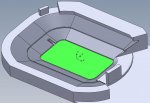This swirling wind question really caught my attention, and I saw an opportunity to perform a CFD Study on the stadium. This meant creating a full-sized 3-d model of the stadium, creating a mesh over the stadium, and sending a flow across the stadium.
I created the model of the stadium by taking measurements off of pictures that were created by HOK in January 2007, and posted on gophersports.com. I used a scaling factor based off of known dimensions (such as the length of the field) to ROUGHLY determine dimensions on the stadium.
<O></O>
I did needed to make a few approximations, such as the size of the smaller scoreboard, where the scoreboards are located, the thickness and height of the walls around the field and at the edge of the stadium, and the location and height of the wall that separates the interior of the stadium from the plaza area. You’ll also notice that the model of the stadium is more square on the enclosed end than round, but I am guessing that the flat, top portion of the stadium will not have a major effect on the results and would just be wasted mesh and more effort to create.
<O></O>
I sent a 10mph wind directly into the open end of the stadium. Just to reiterate, there is a bunch of guess work as to where certain features are located, and the dimensions I used to create the model are not exact. Hopefully, this gives a general idea of what we may see happen should a 10mph wind enter the stadium from the west.
The photos that show just 1/2 of the stadium are cutting away on the plane that runs vertically at the 50 yard line, and on the plane that runs directly down the middle of the field from endzone to endzone. The lone vertical line in the photo looking at the open end of the stadium shows the middle of the field.



